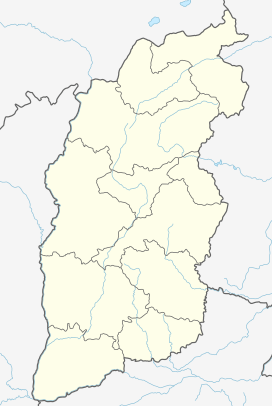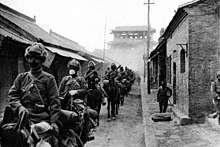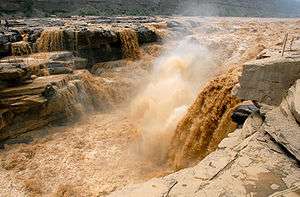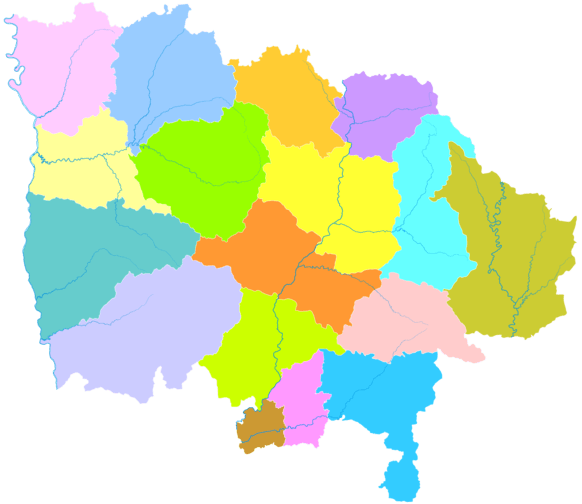Linfen
Linfen is a prefecture-level city in the southwest of Shanxi province, People's Republic of China, bordering Shaanxi province to the west. It is situated along the banks of the Fen River. It has an area of 20,275 square kilometres (7,828 sq mi)[3] and according to the 2010 Census, a population of 4,316,612 inhabitants of which 944,050 live in the built-up (or metro) area made up of Yaodu urban district.[4] The GDP of Linfen ranked second in Shanxi Province. It was known as Pingyang (平陽) during the Spring and Autumn period. In 2006, the American Blacksmith Institute listed Linfen as one of the ten most polluted cities in the world.[5]
Linfen 临汾市 | |
|---|---|
 Drum Tower of Linfen | |
.png) Location of Linfen City jurisdiction in Shanxi | |
 Linfen Location of the city centre in Shanxi | |
| Coordinates (Linfen municipal government): 36°05′17″N 111°31′08″E | |
| Country | People's Republic of China |
| Province | Shanxi |
| County-level divisions | 17 |
| Municipal seat | Yaodu District |
| Government | |
| • Type | Prefecture-level city |
| • CPC Linfen Secretary | Yue Puyu (岳普煜) |
| • Mayor | Liu Yuqiang (刘予强) |
| Area | |
| • Prefecture-level city | 20,275 km2 (7,828 sq mi) |
| • Urban | 60.00 km2 (23.17 sq mi) |
| • Districts[1] | 1,307.0 km2 (504.6 sq mi) |
| Elevation | 452 m (1,483 ft) |
| Highest elevation | 2,346.8 m (7,699.5 ft) |
| Lowest elevation | 385.1 m (1,263.5 ft) |
| Population (2010 census)[2] | |
| • Prefecture-level city | 4,316,612 |
| • Density | 210/km2 (550/sq mi) |
| • Urban | 617,000 |
| • Districts[1] | 950,000 |
| Time zone | UTC+8 (China Standard) |
| Postal code | 041000 |
| Area code(s) | 0357 |
| ISO 3166 code | CN-SX-10 |
| Licence plates | 晋L |
| Administrative division code | 141000 |
| Website | linfen |
| Linfen | |||||||||
|---|---|---|---|---|---|---|---|---|---|
| Traditional Chinese | 臨汾 | ||||||||
| Simplified Chinese | 临汾 | ||||||||
| |||||||||
| Jin Prefecture Jinzhou | |||||||||
| Traditional Chinese | 晉州 | ||||||||
| Simplified Chinese | 晋州 | ||||||||
| |||||||||
| Pingyang Commandery Pingyang | |||||||||
| Traditional Chinese | 平陽郡 | ||||||||
| Simplified Chinese | 平阳郡 | ||||||||
| |||||||||
Prior to 1978, Linfen was famous for its spring water, greenery and rich agriculture and therefore nicknamed "The Modern Fruit and Flower Town". Since then it has been developing into a main industrial center for coal mining, which has significantly damaged the city's environment, air quality, farming, health and its previous status as a green village.
Name

Linfen is named for the Fen River. Its former names include Jin, Jinzhou, and Pingyang (平阳).
History

Chinese archeologists have claimed that Yao's capital was located in Linfen,[6] a confirmation of local legend responsible for the name of the city's Yaodu District. So, Linfen city is the earliest capital of China.
The area was the center of the marchland and duchy of Jin, named for the Jin River (晋水). The duchy collapsed in the 4th century BC but gave its name to a Chinese princely title used as the dynastic name of the Sima clan. Jin Prefecture was centered on the town, which took its name as Jin and Jinzhou. Later, it was renamed Pingyang Commandery, which was also adapted as the name for its chief town.[7] The Xiongnu Chanyu Liu Cong made Pingyang his residence in the fourth century. "He kept court at Pingyang in [Shanxi] and ruled over central and southern [Shanxi], over [Shaanxi] (except for the Han basin), northern [Henan] (except for Kaifeng), southern [Hebei], and northern [Shandong]."[8] In the 10th century, the city's walls were considered "fortified beyond approach".[9]
In the 1980s, Linfen was nicknamed "The Modern Fruit and Flower Town".
Geography
Linfen is located in the southwestern part of Shanxi, on the lower reaches of the Fen River, bounded by Changzhi and Jincheng to the east, the Yellow River to the west (which also forms the border with Shaanxi), Jinzhong and Lüliang to the north, and Yuncheng to the south. The prefecture ranges in latitude from 35° 23′ N to 36° 37′ N, spanning 170 kilometres (110 mi), and in longitude from 110° 22′ E to 112° 34′ E, spanning 200 km (120 mi). In all, the city's administrative area, at 20,275 square kilometres (7,828 sq mi), covers 13% of the province's area.[3]
Within its borders Linfen City has a variety of topographical features. It is characterised as having a "U" shape, with its mountains, covering 29.2% of the prefectural area, on all four cardinal directions, a basin, the Linfen Basin (临汾盆地), covering 19.4%, in the middle, and intervening hills, covering 51.4%, in between.[3] In the east, from north to south, are Mount Huo (霍山) and the Zhongtiao Mountains; in the west are the Lüliang Mountains, with elevations mostly above 1,000 metres (3,300 ft). The highest point in the prefecture is the main peak of Mount Huo, at 2,347 metres (7,700 ft), and the lowest is in Xiangning County, at 385 metres (1,263 ft). Important rivers in the area include the Yellow, Fen, Xinshui (昕水河), Qin (沁河), Hui (浍河), E (鄂河), and Qingshui Rivers (清水河).
The whole prefecture-level city features a great variety of terrain. The city itself sits in a basin, which aggravates the pollution.
Climate
Linfen has a continental, monsoon-influenced semi-arid climate (Köppen BSk), with moderately cold, but dry winters, and hot, somewhat humid summers. The monthly 24-hour average temperature ranges from −2.7 °C (27.1 °F) in January to 26.1 °C (79.0 °F) in July, and the annual mean is 12.6 °C (54.7 °F). The annual precipitation stands at 470 millimetres (18.5 in), with close to 70% of this total falling from June to September. The frost-free period lasts on average 190 days per year. Extreme temperatures have ranged from −22.5 °C (−8.5 °F) to 40.5 °C (104.9 °F).
| Climate data for Linfen (1971−2000) | |||||||||||||
|---|---|---|---|---|---|---|---|---|---|---|---|---|---|
| Month | Jan | Feb | Mar | Apr | May | Jun | Jul | Aug | Sep | Oct | Nov | Dec | Year |
| Record high °C (°F) | 13.8 (56.8) |
21.5 (70.7) |
28.8 (83.8) |
35.0 (95.0) |
38.4 (101.1) |
39.7 (103.5) |
40.5 (104.9) |
39.2 (102.6) |
38.4 (101.1) |
32.5 (90.5) |
25.0 (77.0) |
15.5 (59.9) |
40.5 (104.9) |
| Average high °C (°F) | 4.0 (39.2) |
7.8 (46.0) |
13.8 (56.8) |
21.4 (70.5) |
26.9 (80.4) |
31.3 (88.3) |
32.0 (89.6) |
30.6 (87.1) |
25.8 (78.4) |
19.7 (67.5) |
11.8 (53.2) |
5.3 (41.5) |
19.2 (66.6) |
| Daily mean °C (°F) | −2.7 (27.1) |
1.0 (33.8) |
7.0 (44.6) |
14.3 (57.7) |
19.7 (67.5) |
24.4 (75.9) |
26.1 (79.0) |
24.8 (76.6) |
19.4 (66.9) |
12.8 (55.0) |
5.0 (41.0) |
−1.1 (30.0) |
12.6 (54.6) |
| Average low °C (°F) | −8.2 (17.2) |
−4.5 (23.9) |
1.2 (34.2) |
7.7 (45.9) |
12.7 (54.9) |
17.9 (64.2) |
21.2 (70.2) |
20.2 (68.4) |
14.3 (57.7) |
7.3 (45.1) |
−0.3 (31.5) |
−6.1 (21.0) |
7.0 (44.5) |
| Record low °C (°F) | −22.5 (−8.5) |
−23.1 (−9.6) |
−10.0 (14.0) |
−5.0 (23.0) |
1.3 (34.3) |
8.5 (47.3) |
14.7 (58.5) |
10.7 (51.3) |
2.3 (36.1) |
−5.0 (23.0) |
−12.8 (9.0) |
−17.6 (0.3) |
−23.1 (−9.6) |
| Average precipitation mm (inches) | 3.3 (0.13) |
5.4 (0.21) |
16.8 (0.66) |
26.2 (1.03) |
37.2 (1.46) |
55.2 (2.17) |
119.2 (4.69) |
91.1 (3.59) |
57.0 (2.24) |
36.8 (1.45) |
15.6 (0.61) |
4.7 (0.19) |
468.5 (18.43) |
| Average precipitation days (≥ 0.1 mm) | 2.2 | 2.8 | 4.6 | 5.6 | 6.4 | 8.8 | 12.0 | 10.0 | 8.6 | 6.4 | 3.8 | 2.0 | 73.2 |
| Source: Weather China | |||||||||||||
Pollution
China's rapid industrialization and urbanization beginning in the 1990s led to increased energy demand causing a dramatic increase in the price of coal. This led to a rapid expansion of loosely regulated private mines. Mining, cooking, smelting and other heavy industries which developed around the city have led to catastrophic environmental damage.[10]
In 2006, the Blacksmith Institute included Linfen in its annual "10 worst" report, calling the city the most polluted city in China.[11] It has also been listed as one of the world's ten dirtiest cities by the Popular Science website.[12] The city has ranked at the bottom of the World Bank's air quality rankings.[13]
From its low point, in 2004, with only fifteen days out of the year with an acceptable level of air pollution, the environmental situation has improved.[14] After a series of negative reports on the extreme level of pollution in the city, efforts were made to clean up Linfen. Substandard mines were closed.[10] Coal trucks were kept from entering the city, resulting in much less coal dust. The city has also switched much of its heating source from coal to gas. 197 large coal-fired boilers and more than 600 smaller boilers were decommissioned. As of 2007, 85% of population used natural gas rather than coal for their heating. The State Environmental Protection Agency (SEPA) has forced many of the less-efficient smaller factories to close and enforced stricter standards for larger factories including mandating the installation of sulfur scrubbers.[14]
Since 2006, the government has taken a series of measures to modify industrial structure and economic development mode. Relevant policies was issued such as emission thresholds of industrial pollution. Over the last few years the Ministry of Environmental Protection has been closely monitoring Linfen's environment conditions. While the China Youth Daily reported in 2014 that Linfen experiencing the great change from the "most polluted city" to "model city of environmental protection",[15] other sources suggest that little progress has been made in combatting pollution. In 2018, the Chinese government openly criticized the city's failure to meet pollution targets, and a 2019 report by the Chinese Ministry of Ecology and Environment found that the city's air pollution was the worst among the 168 cities the ministry monitored.[16] Following the report, the city's government ordered further pollution controls for the city's industry.[16]
Administrative divisions
The prefecture-level city of Linfen is divided in one district, two cities and fourteen counties. The information here presented uses the metric system and data from 2010 Census.
| Map | |||||||
|---|---|---|---|---|---|---|---|
| # | English Name | Simplified | Traditional | Pinyin | Area | Population | Density |
| 1 | Yaodu District | 尧都区 | 堯都區 | Yáodū Qū | 1,316 | 944,050 | 717 |
| 2 | Houma City | 侯马市 | 侯馬市 | Hóumǎ Shì | 274 | 240,005 | 876 |
| 3 | Huozhou City | 霍州市 | Huòzhōu Shì | 765 | 282,907 | 370 | |
| 4 | Quwo County | 曲沃县 | 曲沃縣 | Qǔwò Xiàn | 438 | 237,033 | 541 |
| 5 | Yicheng County | 翼城县 | 翼城縣 | Yìchéng Xiàn | 1,163 | 311,471 | 268 |
| 6 | Xiangfen County | 襄汾县 | 襄汾縣 | Xiāngfén Xiàn | 1,304 | 442,614 | 339 |
| 7 | Hongtong County | 洪洞县 | 洪洞縣 | Hóngtóng Xiàn | 1,563 | 733,421 | 469 |
| 8 | Gu County | 古县 | 古縣 | Gǔ Xiàn | 1,193 | 91,798 | 77 |
| 9 | Anze County | 安泽县 | 安澤縣 | Ānzé Xiàn | 1,965 | 82,012 | 42 |
| 10 | Fushan County | 浮山县 | 浮山縣 | Fúshān Xiàn | 946 | 127,831 | 135 |
| 11 | Ji County | 吉县 | 吉縣 | Jí Xiàn | 1,777 | 106,407 | 60 |
| 12 | Xiangning County | 乡宁县 | 鄉寧縣 | Xiāngníng Xiàn | 2,029 | 233,162 | 115 |
| 13 | Pu County | 蒲县 | 蒲縣 | Pú Xiàn | 1,508 | 107,339 | 71 |
| 14 | Daning County | 大宁县 | 大寧縣 | Dàníng Xiàn | 967 | 64,501 | 67 |
| 15 | Yonghe County | 永和县 | 永和縣 | Yǒnghé Xiàn | 1,219 | 63,649 | 52 |
| 16 | Xi County | 隰县 | 隰縣 | Xí Xiàn | 1,415 | 103,617 | 73 |
| 17 | Fenxi County | 汾西县 | 汾西縣 | Fénxī Xiàn | 880 | 144,795 | 165 |
Tourism

Linfen prefecture is home to several notable tourist attractions including the Hukou Waterfall which is the largest waterfall on the Yellow River and the second largest in China. Hukou Waterfall is located 150 km (93 mi) west of Linfen city in Jinshan Gorge.[17]
Other attractions are mostly located in Hongtong county. Most notable among these is Guangsheng Temple, built in 147 CE. Located in the upper Guangsheng temple is the Feihong Pagoda, the largest and best preserved glazed Chinese pagoda.[18][19] Also in Hongdong county is the Su San Prison (苏三监狱), a restored Ming dynasty prison made famous by the Peking opera titled Yu Tang Chun (玉堂春). It is China's oldest surviving prison.[20] Dahuaishu Ancestor Memorial Garden is a shown for the mandatory population migration in early Ming Dynasty.
Demographics
Linfen recorded a population of approximately 4,508,400 people as of 2019, an increase of 80,100 from 2018.[21] The city reported 2,414,700 urban residents, and 2,093,700 rural residents, giving the city a 53.56% urbanization rate.[21] There are 28 ethnic minorities in Linfen with a population exceeding 10,000 people: the Hui, the Manchu, the Tujia, Mongols, the Miao, the Zhuang, Koreans, the Yi, the Buyi, the Bai, Uyghurs, the Mulao, the She, Tibetans, the Li, the Dong, the Yao, Tajiks, the Gelao, the Daur, the Lahu, the Wa, the Hani, the Tu, the Xibo, the Lisu, the Qiang, and the Jingpo.[21]
Economy
As of 2019, the city reported a GDP of 145.26 billion Renminbi.[22] Linfen's primary sector makes up 7.1% of the city's GDP, the secondary sector contributes 43.3% of the city's GDP, and the tertiary sector makes up 49.6% of the city's GDP.[22]
Industry
Linfen has rich mineral resources including coal, iron ore, copper, and lead. Hedong Coal Field, Huoxi Coal Field and Qinshui Coal Field together comprise 62.9 billion tons of coal reserves. Iron ore reserves exceed 420 million tons. Coal mining and dressing, coking, metallurgy, non-ferrous metal smelting, and chemicals are the principle industries.[23]
After a World Bank report in 2006 called Linfen "the most polluted city in the world", the local government began closing a number of mines and factories, costing the city's economy $300 million in 2007 alone.[24] A number of industries also refitted their facilities to track and reduce pollution.[24] The city's economy stagnated in the following years.[25]
Transportation
Air
Linfen Qiaoli Airport, in Yaodu district, was built in 1958 and closed in 1965. The airport has been under renovation since September 2010 and started operation on January 2016. On May 21, 2020, Linfen Qiaoli Airport was officially renamed "Linfen Yaodu Airport" (临汾尧都机场).
Railway
Linfen railway station, in Yaodu district, was built in 1935 on the important southern Tongpu railway.
Linfen West railway station, in Yaodu district, was built in 2014. It is on the Datong–Xi'an high-speed railway. From this station, passengers can go to Beijing, Xi'an, Taiyuan and Shijiazhuang directly.
Education
References
- Ministry of Housing and Urban-Rural Development, ed. (2019). China Urban Construction Statistical Yearbook 2017. Beijing: China Statistics Press. p. 46. Retrieved 11 January 2020.
- 2010年临汾市第六次全国人口普查主要数据公报 [Sixth National Population Census of the People's Republic of China] (in Chinese). National Bureau of Statistics of China. Retrieved 30 August 2012.
- "Geography of Linfen" (in Chinese). Lifen People's Government. Retrieved 2008-09-09.
- (in Chinese) Compilation by Lianxin website. Data from the Sixth National Population Census of the People's Republic of China Archived 2012-03-25 at the Wayback Machine
- Choi, Charles Q. (October 18, 2006). "World's 10 Most Polluted Places". Livescience.com. Retrieved 24 January 2013.
- Xinhua. April 2015.
- p. 46.
- Grousset, Rene (1970), The Empire of the Steppes, Rutgers University Press, pp. 56–7, ISBN 0-8135-1304-9.
- p. 407.
- "China's 'most polluted city' breathes cleaner air". China Daily. November 10, 2012. Retrieved 21 January 2013.
- "Top 10 Most Polluted Places" (Adobe Portable Document Format). Blacksmith Institute. Retrieved 21 January 2013.
- The World's 10 Dirtiest Cities
- Johnathan Watts; Randeep Ramesh (March 26, 2007). "Fighting for air: frontline of war on global warming". The Guardian. Retrieved 20 January 2013.
- FUnk, McKenzie (July 7, 2007). "China's Green Evolution". Popular Science Magazine. Retrieved 21 January 2013.
- China Youth Daily Feb 23, 2014
- "China coal hub Linfen to extend anti-pollution curbs to third quarter: draft plan". Reuters. 2019-04-15. Retrieved 2020-05-16.
- David Leffman; Simon Lewis; Jeremy Atiyah (2003). The Rough Guide to China. p. 263.
- "Feihong Pagoda in Hongtong County of Shanxi Province". China Internet Information Center. Retrieved 24 January 2013.
- Zhang, Zixuan. "Land of fairy tales". China Daily Asia Pacific. Retrieved 24 January 2013.
- David Leffman; Simon Lewis; Jeremy Atiyah (2003). The Rough Guide to China. p. 262.
- 人口状况-市情概况-临汾市人民政府门户网站 (in Chinese). Linfen People's Government. 2020-03-10. Archived from the original on 2020-05-16. Retrieved 2020-05-16.
- 2019年临汾市GDP同比增长6%-统计信息-临汾市人民政府门户网站 (in Chinese). Linfen People's Government. Archived from the original on 2020-05-16. Retrieved 2020-05-16.
- "Linfen (Shanxi) City Information". September 11, 2011. Retrieved 21 January 2013.
- Chang, Emily (2009-12-15). "Choking in China's polluted city - CNN.com". www.cnn.com. Archived from the original on 2020-05-16. Retrieved 2020-05-16.
- 中国 国内生产总值 : 地级市. www.ceicdata.com (in Chinese). Retrieved 2020-05-16.
External links
- Official website of Linfen Government
- LinFen Photo Essay
- A canary in the Chinese coal mine (published 2007-03-02; accessed 2007-04-01)
- BBC article Blacksmith Institute list

